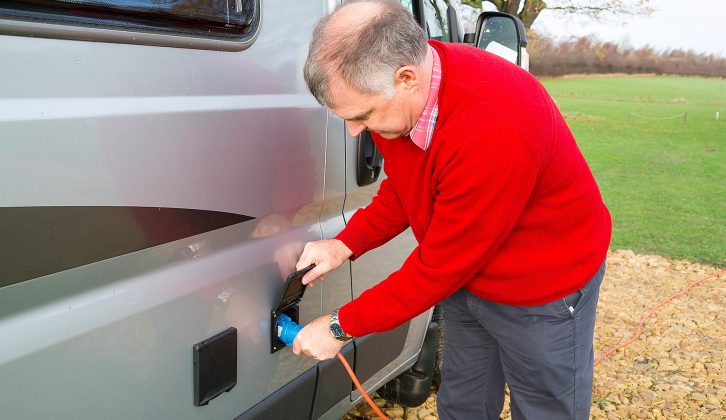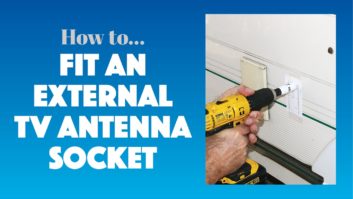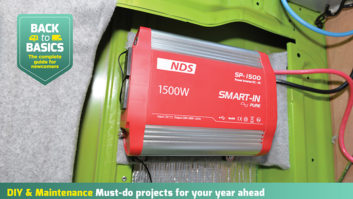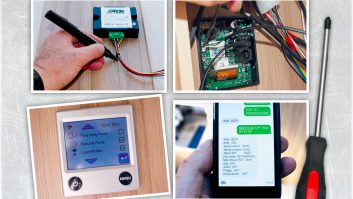EHU, hook-up, shore power… call it what you like, but the umbilical connection to mains electricity is a fundamental part of just about every professionally built motorhome in Europe.
Many motorcaravanners these days enjoy camping off-grid, and that includes yours truly, but camping in the depths of winter in the UK is definitely made more comfortable by using hook-up.
We do have to bear in mind, however, that it is not an unlimited supply. At best it will give us 16 amps but it could be as low as three. So always check before you plug in!
How do you know how much you’re using?
Some equipment will quote the Amps used but most will quote Watts. Now who remembers from their school days what all these terms actually mean?
Amps, or Amperes to use the proper name, is a measurement of current. Volts is a measurement of electrical pressure and Watts is a measure of power.
To calculate Watts you multiply Volts by Amps, so 2A at 230V equals 460W. The full 16A supply would support 3680W – a little over three-and-a-half kilowatts.
Why do you need to know this?
Over New Year, we stayed on a site using mains hook-up to provide power for heating, battery charging and running the fridge.
On the second day, our neighbour called on us to say that their electricity supply had gone off, so I duly reset the trip on the hook-up bollard for them.
Within seconds of the power being restored, though, it tripped off again. But it wasn’t the RCD blowing – it was the 16A circuit breaker.
Looking into our neighbour’s motorhome I immediately spotted the reason. They were running their Truma Ultraheat system on the electric setting at 2000W and had then plugged in an electric kettle.
And this wasn’t a low-wattage travel kettle, but an ordinary domestic one. The total combined power draw would be 5kW, which needs 21A at 230V, hence why the circuit breaker tripped.
Battery chargers and fridges are generally low-power items, with chargers rarely being more than 300W and fridges generally around 100-150W.
But even so, the pair of them will take anywhere up to 2A, therefore you need to factor them in when calculating your amperage needs.
Do your homework!
It could be a good idea if you regularly use mains hook-up to note the wattage and therefore the current requirement for each of your mains appliances. Then you can avoid knocking out the supply post.
If you want to use an electric kettle, it’s also a good idea to get a low-wattage unit of around 1000W, although it will take longer to boil.
If you have mains-powered appliances you need to use when not connected to hook-up you can use an inverter.
This is a device that converts the 12V DC (direct current) supply from your batteries into 230V AC (alternating current). But bear in mind that as the voltage and wattage is increased on the output, so the current required from the batteries increases.
Three amps at 230V would give 690W, but that will require about 60A at 12V.
Don’t waste energy
Sadly, batteries are a pretty low-density energy store so, you either need a big bank of batteries to provide such power for any length of time, or have a means of providing that sort of current at 12 volts – running the engine, for example.
Using an inverter to power heat appliances (hair drier, toaster, kettle etc) is a guaranteed way to kill leisure batteries without a separate means of providing current.
Many people use inverters to power laptops, electric toothbrushes and mobile phone chargers. This is fine as long as you match the inverter output to the power needs of the charger, but using a 2000W inverter to power a mobile phone charger is very wasteful of energy.
Modern inverters are often rated as up to 95% efficient. This means that up to 95% of the low-voltage energy put in is converted into useable 230V power, and the remaining 5% will be given off as heat.
Unfortunately, most inverters only reach these levels of conversion efficiency when they are running at around 75% of their maximum capacity (750W for a 1000W inverter, for example).
Outside of this their efficiency tends to drop off pretty rapidly. If you need to charge mobile phones or laptops, use a readily available 12V charger.
There are, of course, occasions when a 12V charger is not available – mobility scooter batteries or CPAP (constant positive air pressure) machines, for example. If you really do need to use an inverter for something like this, I would strongly recommend you get a pure sine wave unit.
The right tools for the job
To put it simply, the mains electricity we take for granted changes polarity 50 times a second, and the waveform of this alternating current is sinusoidal, a smooth curve.
Cheaper inverters can’t replicate this very well and produce a square waveform with the corners cut off.
This is fine for resistive loads (heating elements, for example) but most electronic devices will not like it and at the very least will run hot. In the worst case scenario they could actually catch fire!
A pure sine wave inverter will produce AC power with a near-perfect sinusoidal waveform that any equipment should be happy to run on.
A keen motorcaravanner, Practical Motorhome’s technical expert Diamond Dave runs his own leisure vehicle workshop. Find out more at Dave Newell Leisure Vehicle Services.
Bear in mind that hook-up is not an unlimited supply of power









